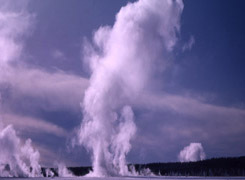
Established in 1872, Yellowstone National Park is America's first national park. Located in Wyoming, Montana, and Idaho, it is home to a large variety of wildlife including grizzly bears, wolves, bison, and elk. Preserved within Yellowstone National Park are Old Faithful and a collection of the world's most extraordinary geysers and hot springs, and the Grand Canyon of the Yellowstone.
History
The human history of the Yellowstone region goes back more than 11,000 years. From about 11,000 years ago to the very recent past, many groups of Native Americans used the park as their homes, hunting grounds, and transportation routes. These traditional uses of Yellowstone lands continued until a little over 200 years ago when the first people of European descent found their way into the park. In 1872 a country that had not yet seen its first centennial established Yellowstone as the first national park in the world. A new concept was born and with it a new way for people to preserve and protect the best of what they had for the benefit and enjoyment of future generations.
Fees
The entrance fee is $25 for a private, noncommercial vehicle; $20 for each snowmobile or motorcycle; or $12 for each visitor 16 and older entering by foot, bike, ski, etc. This fee provides the visitor with a 7-day entrance permit for both Yellowstone and Grand Teton National Parks. Remember to keep your admission receipt in order to re-enter the parks. Snowmobile operators must possess a valid motor vehicle operator's license.
Advance reservations are not needed to enter the park. Annual or Lifetime Passes are possible alternatives to the above fees.
Park Annual Pass
The $50 park annual pass provides entrance to pass holder and accompanying passengers in a single private non-commercial vehicle at Yellowstone and Grand Teton National Parks. Pass is valid for 12 months from date of purchase. Purchase your pass at one of the park’s entrances.
Weather
Summer: Daytime temperatures are often in the 70s (25C) and occasionally in the 80s (30C) in lower elevations. Nights are usually cool and temperatures may drop below freezing at higher elevations. Thunderstorms are common in the afternoons.
Winter: Temperatures often range from zero to 20F(-20 to -5C) throughout the day. Sub-zero temperatures over-night are common. The record low temperature is -66F (-54C). Snowfall is highly variable. While the average is 150 inches per year, it is not uncommon for higher elevations to get twice that amount.
Spring & Fall: Daytime temperatures range from the 30s to the 60s (0 to 20C) with overnight lows in the teens to single digits (-5 to -20C). Snow is common in the Spring and Fall with regular accumulations of 12" in a 24 hour period. At any time of year, be prepared for sudden changes. Unpredictability, more than anything else, characterizes Yellowstone’s weather. Always be equipped with a wide range of clothing options. Be sure to bring a warm jacket and rain gear even in the summer.
Write to
P.O. Box 168
Yellowstone National Park, WY 82190-0168
Phone
Visitor Information
(307) 344-7381
Information for the Hearing Impaired (TDD)
(307) 344-2386
Fax
(307) 344-2014
 Print
Print Email
Email







